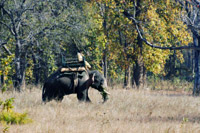A single visit of the Madhya Pradesh state enables a person to come across several towns and places that have flourished over the years. One such place is Katangi. Katangi is a nagar panchayat town, which is situated in the district of Balaghat of the state.
The geographical location of Katangi helps one to identify the town in a much better way.
Katangi has been positioned approximately at 21.78° N and 79.78° E. It also rises to a height of 442 meters or 1450 feet above the mean sea level.
Knowledge about demographical scenario helps any one to gain familiarity with the particular town. In order to achieve the motive, demographers have carried on surveys and researches and thus brought forth important data that are related to Katangi like population status, literacy condition etc. Regarding this, the census report of India that has been published in the year 2001 has drawn the public interest. As per this report, the total population of Katangi showed a count of 14,760. An interesting point about Katangi has been deciphered. In Katangi, both males and females are in equal proportion. It is evident from population status of male and female. In other words, male populace constitutes of 50 percent, while female population too is the same. In Katangi, children who are below six years of age constitutes of 13 percent of the total population.
To support the fact that Katangi is a developed town, one may cite the literacy rate of that particular town as an important evident. From the aforesaid census report, the average literacy rate of Katangi constitutes of 71 percent. Thus it is even higher than that of India, which has been measured to be 59.5 percent. Male literacy of Katangi constitutes of 78 percent while the rate of female literacy is 64 percent.
 Places of interests that have developed in Katangi and its nearby areas are quite significant. Nahlesara Dam, Rampaily Temple, Hatta Bawali (well), Gangulpara Tank and Water Fall and Dhuti Dam deserve mentioning. One can even visit the renowned Kanha National Park.
Places of interests that have developed in Katangi and its nearby areas are quite significant. Nahlesara Dam, Rampaily Temple, Hatta Bawali (well), Gangulpara Tank and Water Fall and Dhuti Dam deserve mentioning. One can even visit the renowned Kanha National Park.
To facilitate accessibility with other places in India this Katangi town is well connected by rails and airport. Airport at Nagpur and Katangi Railway Station lie in vicinity. This railhead has established link between ` Balaghat and Jabalpur`.
More information about Balaghat district can be deciphered. Due to its integrity with the district it is quite natural that Katangi too is going to follow the footsteps of the people of the district. Industries producing ingredients like steel, plastic, edible oil, copper are found in the soils of the district.



















